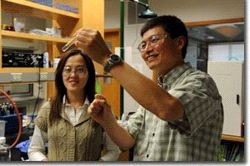Consumables
DuPont, Lehigh Scientists Discover Unique Way to Sort Nanotubes by Species

Friday 17. July 2009 - DuPont and Lehigh University scientists have refined a technique, first published in 2003, to sort carbon nanotubes using specific sequences of DNA. This technique is first demonstration that nanotubes can be sorted by size, property and symmetry.
This new finding was reported in an article in the journal Nature. The study was co-authored by DuPont researchers Ming Zheng and Xiamin Tu, with Lehigh University professor of chemical engineering Anand Jagota and student Suresh Manohar.
There has been great interest in the revolutionary electrical, mechanical and thermal properties of single-walled carbon nanotubes (SWNTs) since their discovery in the early 1990s. However, SWNTs are produced as complex mixtures of different nanotube species with different properties, greatly limiting their applications.
In 2003, a publication in Science by DuPont scientists, including Ming, disclosed a method to separate carbon nanotubes using DNA. This was the first demonstration that the problem of sorting SWNTs could be solved.
The current development is a significant advancement in this pioneering field, perfecting the only approach that uses biological molecules to carry out a refined sorting of carbon nanotubes, separating nanotubes with different optical, electronic and chemical properties.
“Our technique is similar to sorting snowflakes by wrapping DNA around each flake,” Ming said. “Nanotubes come in many sizes and designs, and each type offers unique properties for uses that can range from transistors for electronics, light sources for displays or conducting films for photovoltaic materials. The difficult part of our approach is identifying which DNA sequence is most efficient at separation. Our approach was a bit like probing into the DNA library to determine sequences. Through this approach, we tried over 350 sequences and identified more than 20 that showed useful separation properties.
“We are at a historic moment when biology and materials science meet at the nano-meter scale, and this opens up lots of opportunities for new science and technology development,” Ming said.
